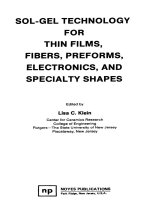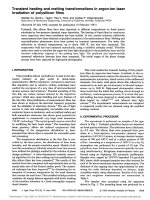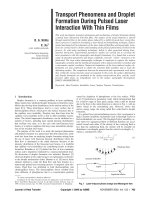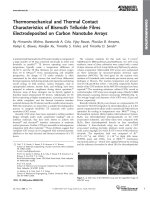foam and foam Films
Bạn đang xem bản rút gọn của tài liệu. Xem và tải ngay bản đầy đủ của tài liệu tại đây (30.04 MB, 797 trang )
STUDIES
IN I N T E R F A C E
SCIENCE
F o a m and F o a m Films
Theory, Experiment, Application
STUDIES
IN I N T E R F A C E
SCIENCE
SERIES E D I T O R S
D. M ~ b i u s
and R. M i l l e r
Vol. I
Dynamics of Adsorption at Liquid Interfaces
Theory, Experiment, Application
by S.S. Dukhin, G. Kretzschmar and R. Miller
Vol. z
An Introduction to Dynamics of Colloids
by J.K.G. Dhont
Vol. 3
Interfacial Tensiometry
by A.I. Rusanov and V.A. Prokhorov
Vol. 4
New Developments in Construction
and Functions of Organic Thin Films
edited by T. Kajiyama and M. Aizawa
Vol. 5
Foam and Foam Films
Theory, Experiment, Application
by D. Exerowa and P.M. Kruglyakov
Vol. 6
Drops and Bubbles in Interfacial Research
edited by D. M6bius and R. Miller
Foam and Foam Films
Theory, Experiment, Application
DOTCHI EXEROWA
Institute of Physical Chemistry
Bulgarian Academy of Sciences
Sofia
Bulgaria
PYOTR M. KRUGLYAKOV
State Academy of Architecture and Building
Penza
Russia
I998
ELSEVIER
Amsterdam
- Lausanne
- New York-
Oxford - Shannon
- Singapore
- Tokyo
ELSEVIER SCIENCE B.V.
Sara Burgerhartstraat 25
P.O. Box 211, iooo AE Amsterdam, The Netherlands
ISBN: o 444 81922 3
© 1998 Elsevier Science B.V. All rights reserved.
No part of this publication may be reproduced, stored in a retrieval system or transmitted in any form or by
any means, electronic, mechanical, photocopying, recording or otherwise, without the prior written
permission of the publisher, Elsevier Science B.V., Copyright & Permissions Department, P.O. Box 521,
IOOO AM Amsterdam, The Netherlands.
Special regulations for readers in the U.S.A. - This publication has been registered with the Copyright
Clearance Center Inc. (CCC), 222 Rosewood Drive, Danvers, MA o1923. Information can be obtained from
the CCC about conditions under which photocopies of parts of this publication may be made in the U.S.A.
All other copyright questions, including photocopying outside of the U.S.A., should be referred to the
publisher.
No responsibility is assumed by the publisher for any injury and/or damage to persons or property as a
matter of products liability, negligence or otherwise, or from any use or operation of any methods, products,
instructions or ideas contained in the material herein.
This book is printed on acid-flee paper.
This book was translated into English from a manuscript in Bulgarian and Russian by
Mrs. Roumyana Stoyanova and Dr. Khristo Khristov, and was edited by Dr. Emil Manev. The
authors appreciate highly their dedicated work and express their deep gratitude.
D. Exerowa
P.M. Kruglyakov
Sofia, September 1997
vi
It is sure4 6 e t t e r t o strive f o r a complete understandiy
of the phenomena than t o despair of the human mind.
After Stephen Hawking
(Hack Holes and Baby Universes and Other Essays
Bantam Books, New York, 1993)
Contents
vii
Preface
Ackmwledgemenls
Ipltroduct ion
Chapter 1
1.1.
1.2.
1 .3.
1.4.
Chapter 2
2.1.
2.2.
2.3.
Formation and Structure of Foams. Pressure in the Liquid
and Gas Phases of Foams
Methods for Foam Generation
Shape of Films and Bubbles in Foam
Foam Dispersi ty
Pressure in Liquid Phase of Foam and Bubbles
References
4
14
25
31
37
Expermineta1 Methods Involved in the Study of Foam Films
Microscopic Thin Liquid Films
2.1.1. Thin Liquid Films: Microinterferometric Technique
2.1.2.Measuring cells for formation and study of microscopic
foam films
2.1.3. Determination of foam film thickness
2.1.4. Determination of the capillary pressure
2.1.5. Determination of the contact angle between the foam film
and the bulk phase
2.1.6, Foam film study with a-particle irradiation
2.1.7. Fluorescence recovery after photobleaching (FRAP)
of foam films
2.1.8. Thin Liquid Films - Pressure Balance Technique
Macroscopic Foam Films
2.2.1. Large flat foam films on a frame
2.2.2. Methods for measurement of foam film elasticity
2.2.3. Techniques for measurement of the lateral electrical
conductivity of foam films
2.2.4. Ellipsometry of black foam films
2.2.5. FT-IR Spectroscopy studies of foam films
2.2.6. X-ray reflectivity of foam films
Spherical Foam Films
2.3.1, Measurement of the coefficient of gas permeability trough
foam films
2.3.2. Method for formation of foam films from insoluble
surfactants
References
42
42
43
Physical Chemistry of Foams Films
Elements of the Thermodynamics of Foam Films
3.1.1. Curved liquid films
3.1.2. Ftane-parallel thin liquid fiIms
88
43
47
50
52
55
56
58
60
61
64
67
70
71
73
74
78
80
89
89
91
viii
Contents
3.2.
3.3.
3.4.
3.1.3. Thermodynamics of foam films
3.1.4. Mechanical model of the foam film and its adjacent
meniscus
3.1.5. Contact angles
3.1.6. Line tension at a circular liquid film
Non-Equilibrium Properties of Foam Films
3.2.1. Kinetics of thinning of foam films
3.2.1.1. Asymmetric drainage of foam films
3.2.1.2. Kinetics of formation of foam films
3.2.2. Kinetics of rupture of foam films
3.2.2.1. Critical thickness of film rupture
3.2.2.2. Critical thickness of rupture and black spot
formation in microscopic foam films
Surface Forces in Foam Films
3.3.1. Disjoining pressure isotherm and experimental
verification of the DLVO-theory
3.3.2. Potential of the diffuse electric layer at solution/air
interface
3.3.3. Surface forces in foam films from amphiphilic block
copolymers
3.3.3.1. Transition from electrostatic to steric stabilisation
in foam films from ABA triblock copolymers
3.3.3.2. Dynamic method for surface force measurment in
foam films from ABA triblock copolymers
3.3.3.3. Disjoining pressure in foam films from ABA
triblock copolymers
Black Foam Films (Nano Black Films)
3.4.1. Surface forces in black foam film
3.4.1.1. Isotherms of disjoining pressure of black films from
non-ionic surfactant solutions
3.4.1.2. Isotherms of disjoining pressure of black films from
phospholipids
3.4.1.3. Isotherms of disjoining pressure of black films from
ionic surfactant solutions
3.4.2. Transition from common black to Newton black films
3.4.2.1. Two equilibrium states of black foam films
3.4.2.2. Experimental investigations of CBF/NBF transition
3.4.2.3. Metastable black foam films
3.4.2.4. Elestrostatic origin of the transition to NBF
3.4.2.5. Main differences between CBF and NBF
3.4.2.6. Thickness transition in foam films
3.4.3. Relationship between black foam film formation and the
properties of the surfactant adsorption layers
3.4.3.1. Properties of the adsorption layers
93
96
98
1 O0
102
102
llO
ll3
ll5
115
118
122
124
134
150
150
157
162
167
168
171
179
191
199
200
201
209
212
216
218
226
226
Contents
3.4.3.2. Probability for observation of black foam films
depending on the adsorption layer state
3.4.3.3. Formation of black foam films from an insoluble
surfactant monolayer
3.4.4. Bilayer Black Foam Films (NBF)
3.4.4.1. Comparison of the lifetime/surfactant concentration
dependence of CBF and NBF
3.4.4.2. Theory of rupture of amphiphile bilayers
3.4.4.3. Experimental results on stability of amphiphile
bilayers
3.4.4.4. Phase transitions in phospholipid foam bilayers
3.4.4.5. Linear energy of holes in amphiphile bilayers
3.4.4.6. Linear energy of the contact line black foam film/
bulk liquid
3.5. Diffusion Processes in Foam Films
3.5.1. Gas permeability of foam films
3.5.2. Gas permeability of NBF
3.5.3. Lateral diffusion in phospholipid black foam films
3.5.4. Lateral diffusion of vacancies in NBF
3.6. Similarity of Foam Films with Emulsion and Asymmetric Thin
Liquid Films
3.6.1. Emulsion films
3.6.2. Asymmetric films of the liquid/liquid/gas type
References
ix
230
234
236
237
238
249
263
273
276
282
282
290
295
300
303
303
309
322
Chapter 4 Foam Structural Parameters and Related Properties: Techniques
for Determination
4.1. Relation between the geometrical (structural) parameters of a foam
and its physicochemical characteristics
4.2. Determination of foam expansion ratio (foam density)
4.3. Determination of pressure in foam Plateau borders
4.4. Determination of foam dispersity
4.5. Study of foam liquid distribution and Plateau border profiles
References
345
Chapter 5
5.1.
5.2.
5.3.
381
381
383
385
385
392
Foam Drainage
A brief characterisation of foam drainage
Techniques for the study of foam drainage
Foam drainage at high pressure drop
5.3.1. Hydrodynamic model of a foam
5.3.2. Liquid flow through polyhedral foams with different types
of foam films
5.3.2.1. Liquid flow in gravitational field
5.3.2.2. Liquid flow under pressure drop
345
357
359
362
375
377
392
397
x
Contents
5.3.3. Equations for drainage under pressure drop
5.3.4. Foam drainage and the kinetics of establishing equilibrium
pressure in the foam liquid phase: experimental studies
5.3.4.1. Kinetics of establishing pressure in the foam liquid
phase
5.3.4.2. Influence of the type of foam films on foam
drainage
5.4. Gravitational drainage of a foam
5.4.1. Equations of gravitational drainage
5.4.2. Initial stage of drainage
5.4.3. Influence of the foam structure and the properties of the
foaming solution on the drainage rate
5.4.4. Drainage of three-phase foams
5.5. Influence of internal foam collapse on drainage
References
Chapter 6 Foam Collapse
6.1. Techniques involved in the study of the kinetics of internal foam
collapse
6.2. Internal foam collapse at diffusion gas transfer
6.3. Coalescence and structural rearrangement
6.4. Kinetics of internal foam collapse
6.5. Decay of the foam column
6.5.1. Foam column decay in gravitational field
6.5.2. Influence of Plateau border pressure on foam column
destruction
6.5.3. Foam breakdown in centrifugal field
6.6. Comparison between the rate of internal foam collapse and the
decrease in foam volume
References
Chapter 7 Foam Stability and the Stabilising Ability of Surfactants
7.1.
7.2.
7.3.
7.4.
7.5.
Definition of the term foam stability and foaming ability of solutions
Characteristics of stability related to foam column decay
Kinetic factors of foam stability
Thermodynamic factors of foam stability
Model approach to the study of foam stability and analysis of
the stabilising factors
7.5.1. Role of foam films in the stability of foams
7.5.2. Stability of a real foam
7.6. Physicochemical properties of surfactants and the stabilising ability
of their solutions
7.6.1. Foam stabilising properties of surfactants determined by
Foam Pressure Drop Technique and Ross-Miles Test
403
409
410
418
420
420
426
431
439
442
442
447
449
455
464
468
473
474
476
486
494
498
502
502
505
510
519
520
520
527
530
534
Contents
7.7.
7.8.
7.9.
7.10.
7.11.
7.6.2. Effect of the isoelectric state at the solution/air interface on
the stability of foams from nonionic surfactants
Dependence of the foaming ability on the mode of foam formation
and the properties of the surfactant solutions
Foaming ability of solutions and foam stability
Stabilising ability and hydrophile-lipophile balance of surfactants
Stability of dynamic foams
Foamed emulsions with large volume fraction of the disperse phase
References
xi
539
543
545
549
556
561
565
Chapter 8
8.1.
8.2.
8.3.
571
571
574
586
586
590
593
601
606
Chapter 9 Foam Breakdown by Antifoams
9.1. Techniques for determination of the defoaming efficiency of
substances
9.2. Adsorption (Homogeneous) mechanism of foam breakdown
9.3. Defoaming in Heterogeneous Systems
9.3.1. Inhibition of black spot formation in microscopic foam
films
9.3.2. Role of antifoam spreading
9.3.3. Mechanism of heterogeneous defoaming
9.4. Defoaming ability of solid hydrophobic particles
9.5. Inversion of the defoaming ability of alcohols
References
610
611
Chapter 10 Technological Application of Foams: Physicochemical Ground
10.1. Classification of foams and films by the properties determining their
technological application
10.2. General principles of regulation of the physicochemical properties
of foams
10.3. Accumulation and separation of surfactants in a foam
10.3.1. Classification of the methods of surface separation
10.3.2. Characteristics of the effectiveness of accumulation,
separation and purification of surfactant solutions
10.3.3. Experimental studies on the accumulation of individual
surfactants and mixtures
656
656
Physical Properties of Foams
Mechanical properties
Rheological properties
Electrical properties
8.3.1. Electrical conductivity
8.3.2. Electrokinetic properties
8.4. Optical properties
8.5. Thermophysical properties
References
619
623
626
628
631
638
647
652
658
663
663
666
682
xii
Contents
10.3.4. Foam separation of surfactant components from mixtures
10.4. Optimisation of the processing properties of solidifying foams
10.4.1. Thermal insulators from frozen aqueous foams
10.4.2. Oligomer polymer foams
10.5. Examples of foam inhibition in the process of extraction and in
emulsion metalworking fluids
10.6. Examples of the use of natural products as foaming agents
10.7. Use of foams in petroleum and gas industries
References
Chapter 11 Black Foam Films: Application in Medicine
11.1. Black Film Method for assessment of foetal lung maturity
11.2. Phase state of foam bilayer (NBF) from amniotic fluid
11.3. A new hypothesis of the structure and stability of alveolar surface
11.4. Black Film Method for assessment of therapeutic surfactants
References
Symbols
Subject index
697
703
704
712
716
718
719
729
738
738
744
751
754
758
761
768
xiii
PREFACE
The first book on soap foams and bubbles appeared at the end of the nineteenth century
(Boys, 1890). The gist of its contents has become considerably outdated but, nevertheless, it has
lost neither its attraction nor its cognitive value to this very day - a fact that has been confirmed
by its undergoing numerous republications. The results of the ongoing investigations on
macroscopic films have been systematised and summarised in K.J. Mysels et al.'s monograph,
while the microscopic films have been surveyed in a number of reviews by A. Scheludko, I.S.
Clunie et al. and others. The processes of foam formation and collapse, especially those with
practical implications, have been dealt with by J.J. Bikerman et al. (1953), E. Manegold (1953, in
German), J.J. Bikerman (1973), V.K. Tikhomirov (1975, 1983), K.V. Kann (1989) and P.M.
Kruglyakov and D. Exerowa (1990), the last three having been published in Russian. A series of
monographic collections, editors R.J. Akers (1976), L.L. Schramm (1984), A.J. Wilson (1989),
N.R. Morrou (1990), R.K. Prud'homme and S.A. Khan (1995) have also treated these topics.
Moreover, a multitude of books and brochures on the practical applications of foam in various
industrial branches like fire-fighting, flotation, oil-production, dust-collection, have come out at
different times. There are a great many cases when we have based ourselves on the books by J.N.
Israelachvili (1985), B.V. Derjaguin, N.V. Churaev and V.M. Muller (1987), B.V. Derjaguin
(1989) which are primarily devoted to surface forces theories, as well as the monograph by S.S.
Dukhin, G. Kretzschmar and R. Miller (1995) on adsorption phenomena at liquid interfaces. This
provoked us to examine some of the above mentioned issues less exhaustively.
In the present monograph, we have attempted to both explain and describe the processes
running in the foams and their equilibrium properties on the basis of quantitative regularities of
electrostatic, molecular, etc. interactions, physicochemical, hydrodynamic and other surface
phenomena. However, considering the complex nature of foam properties, it has, understandably,
proved impossible for a number of properties and processes, still awaiting quantitative
explanation.
The treatment of foam films is important in its own right, thin liquid films being an
effective tool and a luring scientific topic in surface and colloid science. In all justice we must say
that nowadays this scientific domain exists wholly in its own account and its numerous practical
xiv
applications are just one more proof of that. Thin liquid films, and foam films in particular, allow
for direct measurement of the surface forces at play inside them (both DLVO and non-DLVO
forces), establishing their mutual impact etc., leading in turn to the most critical application
possible of surface forces theory, while on the other hand stimulating theoretical analyses. Special
attention has been paid to the transition from long-range to short-range molecular interactions in
thin liquid films which continues to be unfailingly informative about the operation of surface
forces. A new approach to the study of amphiphile (foam, emulsion and membrane) bilayers on
the basis of short-range molecular forces has been set forth, enabling the authors to examine
stability and permeability in terms of a uniform point of view by advancing a hole nucleation
theory. This has also made possible to determine the molecular parameters of the bilayer by
measuring experimentally the macroscopic parameters.
The contents of this monograph have been drawn, primarily, from the findings contained
in the authors and their co-workers studies, including those resulting from the method of Foam
Pressure Drop Technique, developed by P.M. Kruglyakov, Khr. Khristov and D. Exerowa. On the
other hand, the book treats fairly thoroughly the whole array of physicochemical properties of
foam and foam films by pulling on both outstanding older works and the latest achievements in
the research of foams and other disperse systems (especially emulsions) and surface phenomena.
Understandably enough, scrutinising the various foam and film properties has not been
sufficiently uniform which bears on both the state of the art and the authors' interests. It is the
authors' conviction that tradition and continuity are of paramount importance in scientific
progress, thus attempting to include into the book the contributions of the authors pioneering in
this domain. Alongside the literature in English, the monograph draws on, more thoroughly than
usual, scientific results and methods, published in Bulgarian and Russian, therefore, inaccessible
to the majority of readers and not having exerted an overwhelming influence on future works but,
which may, hopefully, be elaborated further. One of the outstanding features of the monograph is
the circumstantial elucidation of the role of foam films in the various processes and phenomena in
the foam itself and a comparison of the foam and foam film properties from different
perspectives. Another original trait of the book is the formulation of the general scientific
principles, underlying the regulation of the physicochemical parameters of foam and foam films
and the technological application of foams based on them. Of course, the applications of foam are
XV
so numerous that they could hardly be outlined comprehensively in a single book. Fore.that reason
the delineation of foam applications has been limited to a finite number of areas, mainly to those
in which the principles of regulating the technological parameters, postulated by the authors can
be utilised or to those which have remained untouched so far. There is also a short review section,
classifying "useful" foams in terms of their most essential property, proving indispensable to the
given field of application. It is also worth remarking that the principal regularities, outlined in the
field of foam films may turn out to be applicable as a model system to study surface phenomena,
to carry out physicochemical description of amphiphile molecules (surfactants, phospholipids and
polymers), to apply in biomedicine etc.
Finally, having in mind that each imperfection could be swallowed more easily when
taken in small doses, we would like to express our regret that this book turned out longer than
originally intended.
This Page Intentionally Left Blank
xvii
ACKNOWLEDGEMENTS
D. Exerowa is a student of A. Scheludko's who has inscribed his name among the
pioneers of the quantitative study of thin liquid films. Both authors are indebted to A. Scheludko
for the invaluable knowledge and the original approach to the scientific quest and wish to render
deep homage to his memory. The authors feel grateful and will remember the frequent
conversations with the late B.V. Derjaguin who gave them valuable knowledge and inspired the
quantitative approach in their research. D. Exerowa is particularly indepted to K. Mysels for
giving the lead towards striving for pioneer scientific quest.
The authors would particularly like to express their gratefulness to Khr. Khristov, T.
Kolarov, R. Cohen, Z. Lalchev, A. Nikolova, B. Balinov, R. Sedev, R. Ivanova, R. Yankov, all
from Bulgaria, and to L.L. Kuznetsova, A.I. Bulavchenko, V.A. Safonov, N.G. Vilkova, T.N.
Khaskova, all from Russia, for their particularly prolific and beneficial participation in the studies
which made this book possible. The authors highly appreciate the joint work with their foreign
colleagues T. Yamanaka (Japan), K. Malysa (Poland), V.M. Muller and Z.M. Zorin (Russia), H.J. Mtiller (Germany), Th.F. Tadros (UK) and E. Scarpelli (USA), the results of which are
included in this book. The authors are also indebted to their colleagues D. Platikanov, B. Radoev
and E. Manev for their precious help and invaluable discussions when writing the respective
sections, related to their own investigations or joint research. D. Exerowa expresses her gratitude
to D. Kashchiev for their joint work on the development of the hole-nucleation theory of rupture
of amphiphile bilayers, and for the agreable and fruitful discussions.
We owe Borislav Toshev deep indebtedness for writing Section 3.1, entitled Elements of
the Thermodynamics of Foam Films, where he advances a new approach to handling thin liquid
film thermodynamics.
Last but not least, we wish to express our deep and cordial thanks to R. Stoyanova and
Khr. Khristov for translating and laying out this book, and to E. Manev for doing the editing job.
D. Exerowa
P.M. Kruglyakov
This Page Intentionally Left Blank
xix
INTRODUCTION
Foam is a widely familiar gas/liquid disperse system. Like other disperse systems, such as
suspensions and emulsions, the foam is characterised by a highly developed interface,
determining its properties. A rewarding investigation of a broad range of surface phenomena
could be carried out in terms of foam and foam films, establishing both the general regularities,
qualifying the various interfaces, and the specific ones, relating to the water/gas interface, which
are equally relevant to biology, ecology, geology and a number of other scientific and
technological domains, touching upon colloid science.
The contacts between the gas bubbles in the liquid when foaming, as well as the contacts
between the emulsion drops and the suspension particles, occur through various thick and thin
liquid layers (films), usually containing surfactants. The properties of disperse systems (foams,
emulsions, suspensions) are largely determined by the properties of these films. Furthermore, the
problem of foam stability is distinct from the problem of colloid solution and emulsion stabilities
whose behaviour is strongly dependent on the process of particle collision. In contrast to other
disperse systems, the individual bubbles in the foam contact immediately after its generation
resulting in formation of foam films that being an essential structural element of the foam,
determine to a great extent foam stability. With the Plateau borders and the vertexes, the films
form a unified capillary system. All the most essential foam processes, including those
determining gas bubble expansion and their lifetime, bear on the thickness, structure and
physicochemical properties of foam films.
The study of the physicochemical properties of the thin liquid films inside the foam itself,
is a task of utmost difficulty. Basing oneself on the findings from foam investigations, one could
only approximately evaluate film thickness, structure and composition, failing to determine the
liquid distribution among films and borders in the foam. A number of essential thermodynamic
parameters, such as the film tension, the contact angles between the films and the bulk phase, the
difference in the surfactant amount adsorbed in the thin and thick films, as well as many other
directly measurable characteristics of foams (and emulsions) still defy our investigations.
Considerable progress in the study of thin film properties, including the reasons for their stability,
XX
has recently been made owing to the investigations on model microscopic films: single thin films,
obtained by a special technique and proved to be a practically adequate model of the film
structure in a polyhedral foam. It has become possible to perform direct and precise
measurements of the various film parameters (thickness, tension, contact angles, diffuse electric
layer potential, etc.). The application of the model systems has permitted a sufficiently
comprehensive study of the hydrodynamics of non-equilibrium films, the surface forces of
different origin: electrostatic, van der Waals, hydration, steric, hydrophobic, etc., the dependence
of black film thickness and composition on the surfactant kind, electrolyte concentration, pH and
temperature. Furthermore, the existence of different types of foam films has been established and
the transition between them. A theory of bilayer black foam film rupture has been developed.
The thinnest-black films have been found to play a particularly important role in the
formation of highly stable foams. They are used as models in the study of surface phenomena at
various interfaces, molecular interactions between two contacting phases at short distances,
including at bilayer contact. This fact in itself is of the utmost importance in studying the
formation and stability of concentrated disperse systems and in modelling the contact between the
two biomembranes. For this reason the book discusses different aspects of black foam films and
some intriguing perspectives for future development, for instance, as a self-organising
nanomolecular system, have been pointed out.
The physicochemical properties of foam and foam films have attracted scientific interest
as far back as a hundred years ago though some investigations of soap foams were carried out in
the seventeen century. Some foam forming recipes must have been known even earlier. The
foundations of the research on foam films and foams have been laid by such prominent scientists
as Hook, Newton, Kelvin and Gibbs. Hook's and Newton's works contain original observations
on black spots in soap films.
The first systematic study of the various properties of soap films has been conducted by
the Belgian scientist Plateau. Using the findings from investigations on the structure and
properties of differently shaped films, he was the first to draw attention to that part of the film
which contacts the surface holding the film. It came to be called Plateau border. Plateau studied
the impact of various external effects (like the stream of air, evaporation, etc.) on the behaviour of
xxi
foam films (1861). In his view, the reason for the long lifetime of soap films, i.e. their high
stability, was related to their surface viscosity and proposed a special method to measure it.
Marangoni (1871) was the one to account for the conclusions from Plateau's observations by the
compression or, respectively, the expansion of the surfactant monolayer, i.e. those monolayer
properties which are now known as the Marangoni effect (of dynamic elasticity), having acquired
wide popularity. Another reason for film stability (equilibrium elasticity) has been established by
Gibbs (1878), who is also responsible for a number of significant ideas concerning soap film
stability. The first theory of soap film rupture has been put forward by Dupre (1869). In the early
twentieth century, the works of Johonnot (1906), Rickenbacher 19.16) and Perrin (1918) have
shed additional light by showing the existence of two varieties of black films without indicating
the reasons for their formation and stability. There were attempts, first by Plateau, then by
Reynolds, to determine the radius of the molecular action studying the dependence of the surface
tension of the film on its thickness. However, the sensitivity of the techniques employed was
insufficient and the object of study was improperly chosen, so they were not successful in finding
the tension difference.
Further progress in the foam film research was achieved in the second half of twentieth
century with the studies of Derjaguin, Mysels, Scheludko and many other scientists whose work
has been referred to repeatedly in the present monograph. They have contributed to reaching the
contemporary understanding of the foam films and foams
Foam is widely applied in a large variety of industrial branches and the claims put forward
to it are largely dependent on its technological applications which are often mutually exclusive. A
case in point is flotation foam which, as a rule, being quite unstable and containing dissolved
substances, guarantees the selective mineral particle extraction from suspensions. Frozen foams
which have been used in the thermal insulation of paint ground coats are expected to have, prior
to crystallisation, low expansion ratio and low drainage rate. On the contrary, foam designed to
carry out adsorption concentration or foam chromatography should be readily dried and highly
stable. Foam, resistant to strong and quick deformations and the impact of organic liquids and of
solid particles of various kinds, has proved to be invaluable in washing away gas pipes, in
cleaning greased products, in carrying out enhanced oil recovery as well as in dust collection.
xxii
The scientific principles for regulating the physicochemical properties of foams targeted at
producing foams, possessing the indispensable technological and exploitation qualities, has
powerfully established itself. This problem could be solved by determining the quantitative
relationships between the essential foam structure parameters (expansion ratio, dispersity, bubble
shape, film thickness and capillary pressure) and the kinetic regularities of the processes,
controlling foam stability (drainage, gas diffusion transfer into the foam, coalescence and the
rupture of the film and the collapse of the foam as a whole). Consequently, to optimise the
properties of foam, it is necessary to create efficient methods to investigate the structure of
parameters and processes, running in the foams, under conditions corresponding to their
application, for instance, when in contact with organic liquids, when flowing in porous media,
when frozen, etc.
As it is well known, science has made a significant step forward owing to the powerful
link between colloid science and the study of biological structures and materials. Thus, an
opportunity arises for these findings to be applied in medicine, both by creating new diagnostic
methods, and by gaining an insight into the mechanism of crucial physiological processes and
biostructures whose biological functions are essential. It is exactly these matters that are dealt
with in the last chapter of the book which makes the reader well aware of the fact that the black
foam film has an alveolar analogue in vivo indicating what the future prospect for advancement
in that domain. Many of the results on the molecular interactions obtained employing thin liquid
films, in the first place being the black foam films, can ground the understanding of the formation
and stability of biostructures.
CHAPTER 1
FORMATION AND STRUCTURE OF FOAMS. PRESSURE IN THE LIQUID
AND GAS PHASES OF FOAMS
Foam is a disperse system, consisting of gas bubbles, separated by liquid layers.
Dispersion of gas in liquid in which the gas content is low and the thickness of liquid layers is
commensurable to gas bubble size is called gas emulsion or spherical foam ("kugelschaum"
by Manegold [1 ]). The shape of bubbles in the gas emulsion is spherical (if their size is not
very big) and there is no contact between them.
Gas emulsions [2-4] are formed during several technological processes (gas adsorption
and desorption, liquid boiling, polymer processing, carbonated beverages, etc.). They are also
formed in nature: gas emitted from swamps and water basins at degradation of organic matter,
in rough sea, recovery of oil containing dissolved gases, etc.
Gas emulsions in which the dispersion medium is of low viscosity are referred to as
short-living disperse systems. Because of the significant difference in the densities of gas and
liquid they quickly separate into pure dispersion medium and foam. The latter either decays
rapidly or transforms into polyhedral foam, depending mainly on the kind and concentration
of surfactants in the foaming solution. Long-living spherical foams can be formed by high
viscosity liquids, for example, molten glass submitted to quick cooling raises sharply its
viscosity thus impeding the movement, contact and coalescence of individual gas bubbles.
Transformation of gas emulsion into polyhedral foam begins when the gas content in foam
becomes higher that 50-75%. It is not possible to obtain stable (long-living) foams from pure
liquid. Stable polyhedral foams are formed only in the presence of an appropriate surfactant
(or surfactant mixtures). Introduction of a surfactant into a liquid significantly changes the
properties of gas dispersions and liquid films. It lowers the surface tension at the gas/liquid
interface, facilitates the dispersion of gas and reduces the size of bubbles, changes the velocity
and regime of bubble rise.
The main stages of foam formation can be established through observing the behaviour
of a certain number of rising bubbles. When bubbles are formed or created in a surfactant
solution, an absorption of the surfactant starts at their interface. Reaching the liquid surface
each bubble forms a hemispherical liquid film which consists of two surfactant adsorption
2
Chapter 1
layers and a liquid core between them (Fig. 1.1). The surfactant adsorption layers ensure long
lifetime of the liquid films formed. With the increase in the number of bubbles at the surface
they begin to draw closer. Furthermore, the capillary attraction between bubbles helps the
process of bubble contact and deformation, resulting in thin liquid film formation between
neighbouring bubbles. Thus, a monolayer of gas bubbles is formed at the surface, followed by
a second layer, and so on until a three-dimensional foam is obtained. When other methods of
foam formation are employed (for example, injection of gas through gauzes, wetted with
surfactant solution) gas bubbles acquire a polyhedral shape in the process of creation.
GAS
-- d
'~
-
-
~,
SOLUTION
Fig.l.1.
Scheme illustrating the formation of a foam film when the bubble reaches the surface of a
surfactant solution.
At the very moment of its formation the foam begins to decay due to various processes
occurring in it, the most important being: film thinning, liquid drainage due to gravity, gas
diffusion from smaller bubbles through the liquid films to bigger bubbles and rupture of films,
the latter causing coalescence of neighbouring bubbles. The change in bubble size and their
disappearance leads to structural reorganisation of the foam. Moreover, evaporation of liquid
as well as destruction of the foam column occurs when the foam is open to the atmosphere.
The most important parameters characterising a polyhedral foam are expansion ratio,
dispersity and foam stability. The expansion ratio n is the ratio between the foam volume VF
and the volume of the liquid content VL in it









